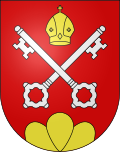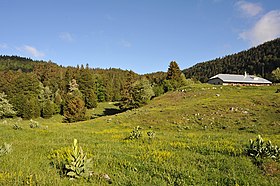La rib
| La rib | |
|---|---|
| State : |
|
| Canton : |
|
| District : | Nyon |
| BFS no. : | 5726 |
| Postal code : | 1278 |
| Coordinates : | 500928 / 137486 |
| Height : | 528 m above sea level M. |
| Height range : | 486–1674 m above sea level M. |
| Area : | 16.59 km² |
| Residents: | 1167 (December 31, 2018) |
| Population density : | 70 inhabitants per km² |
| Website: | www.larippe.ch |
|
La Combe du Faoug |
|
| Location of the municipality | |
La Rippe is a municipality in the Nyon district in the canton of Vaud in Switzerland .
geography
La Rippe is 528 m above sea level. M. , 7 km west of the district capital Nyon (air line). The village extends at the southern foot of the Jura , at the foot of La Dôle , on a slope above the valley of the Boiron de Nyon river .
The 16.6 km² municipal area covers a section of the Vaud Jura and the southern slopes of the Jura. The municipal floor extends from the foot of the Jura to the northwest up the densely wooded steep slope ( Bois Badis ) of the Jura up to the anticline of La Dôle. The summit of La Dôle is 1677 m above sea level. M. the highest point of La Rippe. The westernmost part of the municipality lies in the headwaters of the Valserine . On the ridge of La Dôle there are extensive Jura high pastures with the typical mighty spruce trees , which either stand individually or in groups. In 1997, 4% of the municipal area was in settlements, 59% in forests and woodland, 36% in agriculture and a little less than 1% was unproductive land.
The hamlet of Tranchepied ( 528 m above sea level ) at the foot of the Jura and a few individual farms belong to La Rippe . The neighboring municipalities of La Rippe are Gingins in the north, Chéserex in the east and Crassier in the canton of Vaud in the south-east and Divonne-les-Bains in the south and Prémanon in neighboring France in the west .
population
With 1167 inhabitants (as of December 31, 2018), La Rippe is one of the smaller municipalities in the canton of Vaud. 76.8% of the residents are French-speaking, 11.4% English-speaking and 7.2% German-speaking (as of 2000). The population of La Rippe was 316 in 1900. After 1970 (307 inhabitants) a rapid increase in population began with a tripling of the number of inhabitants within 30 years.
economy
Until the second half of the 20th century, La Rippe was mainly an agricultural village. Today agriculture focuses on arable farming in the lower parts of the community, as well as on cattle and dairy farming on the Jura heights. There are other jobs in wood processing, in local trade and in the service sector. In the last few decades the village has developed into a residential community. Many workers are commuters who work mainly in Nyon and Geneva .
traffic
The community is away from major thoroughfares, but is easily accessible from Nyon . La Rippe is connected to the public transport network by the Postbus course, which runs from Nyon to Coppet .
history
The first written mention of the place took place in 1384 under the name de Rippis , later the names Rispas and Rispis appeared . The current municipality of La Rippe belonged to the Abbey of Saint-Claude in France in the Middle Ages and was ceded to the Cistercian monastery of Bonmont in 1307 . Since 1319 it was under the protection of the House of Savoy .
With the conquest of Vaud by Bern in 1536, La Rippe came under the administration of the Bailiwick of Nyon and in 1711 to the Bailiwick of Bonmont. After the collapse of the Ancien Régime , La Rippe belonged to the canton of Léman from 1798 to 1803 during the Helvetic Republic, which then became part of the canton of Vaud when the mediation constitution came into force . In 1798 it was assigned to the Nyon district. In 1826 the hamlet of Tranchepied, which previously belonged to Chéserex, came to La Rippe. The village does not have its own church, it belongs to the parish of Crassier .
Attractions
Web links
- Official website of the municipality of La Rippe (French)
- Aerial photography
- Germain Hausmann: Rippe, La. In: Historical Lexicon of Switzerland .
Individual evidence
- ↑ Permanent and non-permanent resident population by year, canton, district, municipality, population type and gender (permanent resident population). In: bfs. admin.ch . Federal Statistical Office (FSO), August 31, 2019, accessed on December 22, 2019 .



